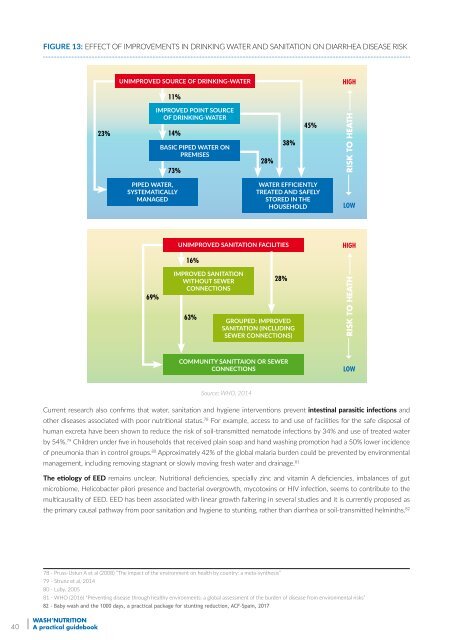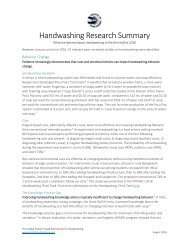WASH’ Nutrition
manuel_wash_nutrition_online
manuel_wash_nutrition_online
Create successful ePaper yourself
Turn your PDF publications into a flip-book with our unique Google optimized e-Paper software.
Figure 13: Effect of improvements in drinking water and sanitation on diarrhea disease risk<br />
UNIMPROVED SOURCE OF DRINKING-WATER<br />
HIGH<br />
11%<br />
23%<br />
IMPROVED POINT SOURCE<br />
OF DRINKING-WATER<br />
14%<br />
BASIC PIPED WATER ON<br />
PREMISES<br />
73%<br />
28%<br />
38%<br />
45%<br />
RISK TO HEATH<br />
PIPED WATER,<br />
SYSTEMATICALLY<br />
MANAGED<br />
WATER EFFICIENTLY<br />
TREATED AND SAFELY<br />
STORED IN THE<br />
HOUSEHOLD<br />
LOW<br />
UNIMPROVED SANITATION FACILITIES<br />
HIGH<br />
16%<br />
69%<br />
IMPROVED SANITATION<br />
WITHOUT SEWER<br />
CONNECTIONS<br />
63%<br />
28%<br />
GROUPED: IMPROVED<br />
SANITATION (INCLUDING<br />
SEWER CONNECTIONS)<br />
RISK TO HEATH<br />
COMMUNITY SANITTAION OR SEWER<br />
CONNECTIONS<br />
LOW<br />
Source: WHO, 2014<br />
Current research also confirms that water, sanitation and hygiene interventions prevent intestinal parasitic infections and<br />
other diseases associated with poor nutritional status. 78 For example, access to and use of facilities for the safe disposal of<br />
human excreta have been shown to reduce the risk of soil-transmitted nematode infections by 34% and use of treated water<br />
by 54%. 79 Children under five in households that received plain soap and hand washing promotion had a 50% lower incidence<br />
of pneumonia than in control groups. 80 Approximately 42% of the global malaria burden could be prevented by environmental<br />
management, including removing stagnant or slowly moving fresh water and drainage. 81<br />
The etiology of EED remains unclear. <strong>Nutrition</strong>al deficiencies, specially zinc and vitamin A deficiencies, imbalances of gut<br />
microbiome, Helicobacter pilori presence and bacterial overgrowth, mycotoxins or HIV infection, seems to contribute to the<br />
multicausality of EED. EED has been associated with linear growth faltering in several studies and it is currently proposed as<br />
the primary causal pathway from poor sanitation and hygiene to stunting, rather than diarrhea or soil-transmitted helminths. 82<br />
78 - Pruss-Ustun A et al (2008) “The impact of the environment on health by country: a meta-synthesis”<br />
79 - Strunz et al, 2014<br />
80 - Luby, 2005<br />
81 - WHO (2016) “Preventing disease through healthy environments: a global assessment of the burden of disease from environmental risks”<br />
82 - Baby wash and the 1000 days, a practical package for stunting reduction, ACF-Spain, 2017<br />
40<br />
<strong>WASH’</strong><strong>Nutrition</strong><br />
A practical guidebook



